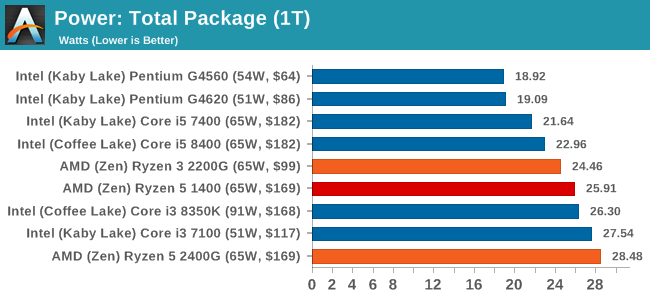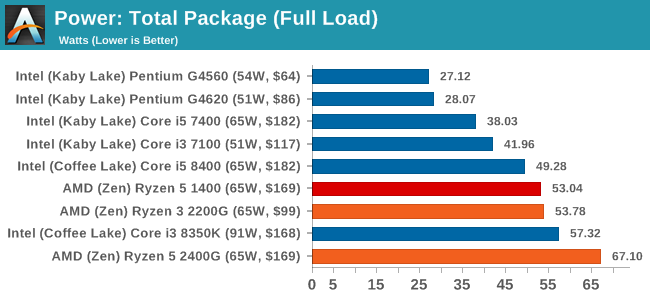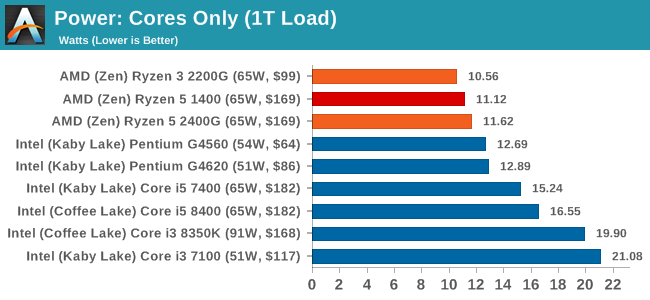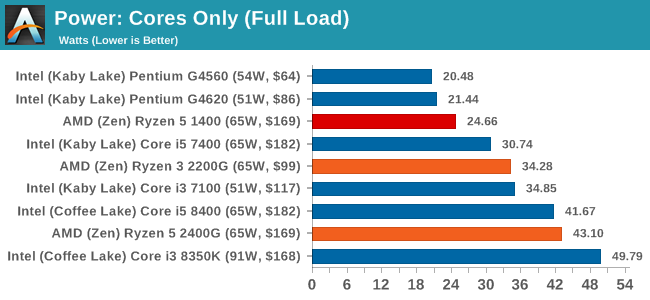Marrying Vega and Zen: The AMD Ryzen 5 2400G Review
by Ian Cutress on February 12, 2018 9:00 AM ESTPower Consumption
For our power consumption metrics, we use a Prime 95 blend on fixed threads to generate a strong load, and then poll the internal power registers that determine power state calculations to get the power consumption. Each processor is different in how it reports its power, which depends on the level of control the processor has: some of the more advanced CPUs, such as Ryzen, will provide per-core power numbers, while the latest Intel CPUs only give a figure for the CPUs as a whole but also include DRAM controller and uncore power consumption.
An interesting element to the power consumption on the Ryzen APUs, due to the unified power delivery subsystem in play feeding the CPU and the integrated graphics, is that the power registers only report half the power consumption when probed (e.g. when 14W, shows 7W). As of yet, we are unsure if this has a knock-on effect on how the processor adjusts its turbo modes in response to power consumption. Nonetheless, a simple scaling factor gives the following results.
Total Package: The Whole Processor
For this data, we take the values of the processor as a whole, which includes all the interconnect, memory controllers, PCIe root complexes, etc. The system is still only loading the CPU cores with minimal effect on the rest of the system, however depending on how the power is managed, some of the sub-systems still remain enabled.


At full load, the difference between the Ryzen 5 and the other Ryzen CPUs shows that the 2400G is using more of its upper margin, compared to the 1400 which is rated at the same power (note TDP is only determined at the base frequency), but the extra frequency of the 2400G means that there is extra power draw overall. Part of this is due to the Infinity Fabric, which we will see below. But what these tests also underline is that in a quad-core configuration, the Intel CPUs are still very power efficient.
Cores Only: Pure Work
For the processors that split out the data, we can look at the power consumption of the cores on their own, without any of the sub-systems, like uncore, mesh, or infinity fabric. This usually paints a different picture to the package power.


For the core only power, the Ryzen 5 2400G uses less power than the Core i3-8350K, despite the situation being reversed when considering the whole package. This means that Infinity Fabric takes a lot of power here, and the ring bus solution that Intel uses benefits from being simpler, and Intel can push more power to its individual cores.










177 Comments
View All Comments
SSNSeawolf - Monday, February 12, 2018 - link
Wonderful, that's understandable. Always appreciate the time you take to slog through the comments, Ian.HStewart - Monday, February 12, 2018 - link
It might be me - unless you are really serious gamer and need high end performance, I see no reason to use a desktop CPU and GPU in todays world.Holliday75 - Monday, February 12, 2018 - link
That appears to be the case. This CPU would be my go to option for any family member wanting a PC these days. The flexibility it offers is remarkable.B3an - Monday, February 12, 2018 - link
Mistake on the Blender benchmark. The latest version is 2.79 but you've put "2.78". Being as you also have a nightly build you might even have 2.8 if you've got it from the 2.8 nightly branch. Either way you will have at least 2.79.milkod2001 - Monday, February 12, 2018 - link
Looks like decent but still 720 gaming at the best. How far away are we from 40-50fps 1080p gaming from APU?richardginn - Monday, February 12, 2018 - link
Depending on the game you are going to play you will need low settings to get 40-50fps 1080p gaming from this APU,.Yaldabaoth - Monday, February 12, 2018 - link
Great article. However, because I am a pervert, I would LOVE to see some heterogeneous GPU action going on. "Does an AMD 2400G and a nVidia 1050 make a baby that is like a 1050 TI? What about if it mated with a Vega 56 or 580?" Know what I mean? [Nudge-nudge] Know what I mean?Threska - Wednesday, February 14, 2018 - link
Heterogeneous would be an APU, not crossfire. Far as AMD's plans with HSA who knows? They're not doing much talk about it since Zen came out. Maybe they don't need it now that their single thread performance is competitive?Pork@III - Monday, February 12, 2018 - link
Core i7-8809G will smash easily Ryzen 5 2400Ganactoraaron - Monday, February 12, 2018 - link
If cost is no concern, then yes.